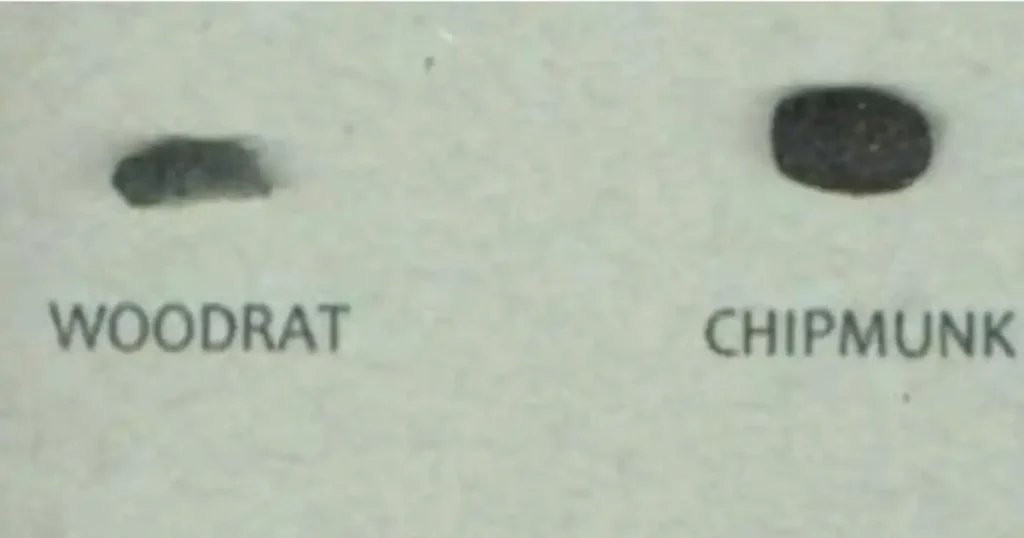
If you’ve spotted chipmunk poop around your yard or home, your first thought might be: what critter left that behind? Good news—it might not be chipmunks after all!
In this article, we’ll dig into what chipmunk poop looks like, where they leave it, and what to do if you find it.

Ever wondered how to tell if you're looking at chipmunk poop? It's surprisingly easy once you know what to look for.
Chipmunk poop resembles that of rats and mice—small, dark, and shaped like tiny pellets with slightly pointed ends. Each dropping is about one centimeter long, smaller than rat poop but bigger than what a mouse leaves behind. Chipmunk droppings are typically brown to black, while mouse droppings may be lighter in color, and rat droppings are often jet black and chunkier.
Think of these droppings as a "middle-sized" clue in the mystery of rodent droppings.
Not exactly. Chipmunks are clever about where they poop. Since their droppings can attract predators, they tend to keep their surroundings tidy and use a designated bathroom spot, usually hidden deep inside their burrow.
That said, if a chipmunk has made its way into your basement or shed, you might find chipmunk poop in one specific area, not scattered all over like you might see with other pests.
Inside a chipmunk’s burrow, there are separate “rooms” for sleeping, storing food, and—yes—pooping.
Found chipmunk poop in or around your home? Don’t grab a broom just yet.
According to CDC recommendations, you should wait about a week after the last known chipmunk activity before cleaning. This delay helps ensure any viruses in the droppings have died off.
Here’s how to clean up these droppings the right way:
Yes! Chipmunks live in underground burrows. Their entrances are often so subtle that you could walk right past one without noticing. Unlike gopher or mole holes, chipmunk holes don’t have a mound of dirt—just a small, flat opening about 2–3 inches wide.

Think you’ve found some mysterious droppings in the corner of a room? Before you panic, take a closer look—chipmunk poop pictures online can help you confirm if that tiny visitor is actually a chipmunk. The droppings are usually small, dark, and pellet-shaped, with tapered ends, and are often left in one concentrated spot.
While it’s uncommon, chipmunks do occasionally wander indoors. If you’re hearing faint scurrying or spotting droppings in low-traffic areas, it’s possible a chipmunk has snuck in. These animals are shy and avoid humans, usually hiding quietly in walls, basements, or storage rooms.
The Humane Society suggests a hands-off approach first:
If that doesn’t work, you can try a humane live trap baited with peanut butter. Or, using thick gloves, gently guide the chipmunk into a towel and release it outside.
Still unsure? Comparing your discovery to chipmunk poop pictures can help confirm if that’s your culprit—and guide your next steps.
Unlike mice and rats, chipmunks are primarily active during the day. That’s right—they’re diurnal, meaning they’re most active while the sun’s up.
So if you’re hearing noises during the day, there’s a better chance it’s a chipmunk and not a nocturnal pest like a rat or mouse.
Back to chipmunk poop—how does it compare?
Chipmunk droppings are small but firm, and they tend to hold their shape longer than mouse poop, which can dry out and crumble. Mouse droppings also tend to have a more pungent odor.
These differences make it easier to tell if you’re dealing with chipmunks—or if your real problem might be mice.
Chipmunks are surprisingly flexible. They can squeeze through openings as small as 2 inches wide. That means even the tiniest gap in your home’s foundation, siding, or vents could be a welcome mat for a chipmunk.
To keep them out, thoroughly inspect both the inside and outside of your home and seal off any access points you find.
Yes, if you don’t take it far enough. Chipmunks possess an extraordinary sense of direction and can navigate their way home from several miles away.
If you’re relocating one, it’s best to take it at least 10 miles from your property.
Still, keep in mind—chipmunks aren’t typically destructive. They dig small holes, stash food, and may nibble on plants, but they’re not out to wreck your home.
Want to protect your garden without hurting the local wildlife? Try:

Whether you’re dealing with a mystery pile of droppings or an unexpected houseguest, knowing how to identify and manage chipmunk poop is key to keeping your home safe and stress-free. With the correct information and a humane approach, you can coexist with these little diggers—or keep them out for good.
For expert rat extermination and humane squirrel removal Dallas services, contact Critter Stop.
Critter Stop has built a fantastic reputation for providing high-quality work and excellent customer service. Trust the professionals at Critter Stop to handle your rodent problems with care and expertise.
If rats are causing problems, such as raiding trash cans or damaging property, there are humane ways to address the issue.
At Critter Stop, we have provided our rat removal services for years in the North Texas area, helping customers protect their family, pets, and property from rat damage.
Contact us at (214) 234-2616 to get a free estimate of our services.
Visit our Critter Library and learn more about our furry friends